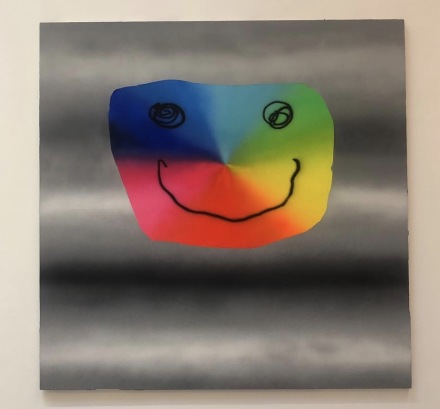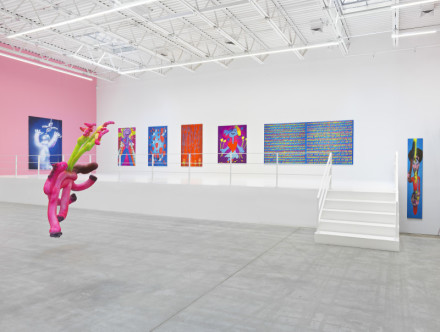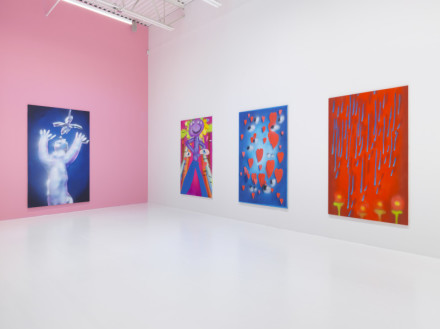
Austin Lee, Feels Good (Installation View), via Art Observed
Part of a young crop of digital natives exploring convergences between physical and digital art practices, artist Austin Lee’s work feels particularly vivid and important. While earlier generations of artists began their careers sketching on paper, Lee began by using Photoshop and other digital tools to sketch on his computer. His work combines the latest image making technologies with traditional artistic processes. He uses the airbrush and the paintbrush to create luminous paintings that evoke both the light of a computer screen and the bold coloration of color field painting.

Austin Lee, Feels Good (Installation View), via Jeffrey Deitch
Now, Lee’s work has come to New York City, taking over Jeffrey Deitch’s downtown exhibition space with a selection of colorful, bright compositions. Extending pop art into the present era, his compositions explode with a vital, cartoonish energy, showcasing both comical scenes (in one piece, a lion devours a figure, but its rudimentary depiction seems to disarm the gruesome subject matter) and renderings of the body. One sculpture marches, grinning across the floor of the gallery, its body bearing a similarity to the classic clay figure Mr. Bill, but twisted into a sort of surreal, psychedelic format.

Austin Lee, Feels Good (Installation View), via Jeffrey Deitch
These works are a distinct product of the modern age. Lee fuses digital techniques with traditional painting and sculptural processes to create his works, using software and 3-D rendering programs to trace his figures, “humanizing†digital sketches into lush paintings and vibrant sculptures. He alsoLee uses 3-D modeling software to manipulate perspective in both his paintings and sculptures, creating new, twisting forms that push the familiar through am otherworldly lens. Yet these’s equally a question of translation at play here, the idea of Lee working through multiple abstractions of the image, both by the brush and the software that approximates its movements, resulting in a form that both parodies the idea of the modern painting, and equally depicts a form that is the product of multiple acts of translation. This is not so much an exploration of a distorted reality in its own right, but rather, the result of what happens when an image is processed through the lenses of multiple programs, frames and functionalities.
The show closes May 18th.

Austin Lee, Feels Good (Installation View), via Jeffrey Deitch

Austin Lee, Feels Good (Installation View), via Jeffrey Deitch
— D. Creahan
Read more:
Austin Lee:Â Feels Good [SExhibition Site]



